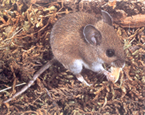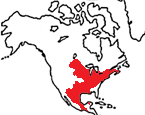|
White-footed Deermouse
(Peromyscus leucopus) |
||||
|
|
Physical
characteristics and distribution
|
|
Head and body length of Peromyscus species range from
70-170 mm and tail lengths are 40-205 mm. There are 2 subgenera
and 55 species. P. leucopus has soft dense fur and large
ears which are covered with fine hairs. The tail is about one
third the length of the total length of this mouse, and is also
covered with fine hairs. Females have four or six mammae. They eat seeds, nuts, berries, fruits, insects and other
small invertebrates and carrion. |
|
Description
of the brain
|
|
Animal
source and preparation
|
|
All
specimens collected followed the same preparation
and histological procedure.
|
Other Related Resources (websites and publications)



